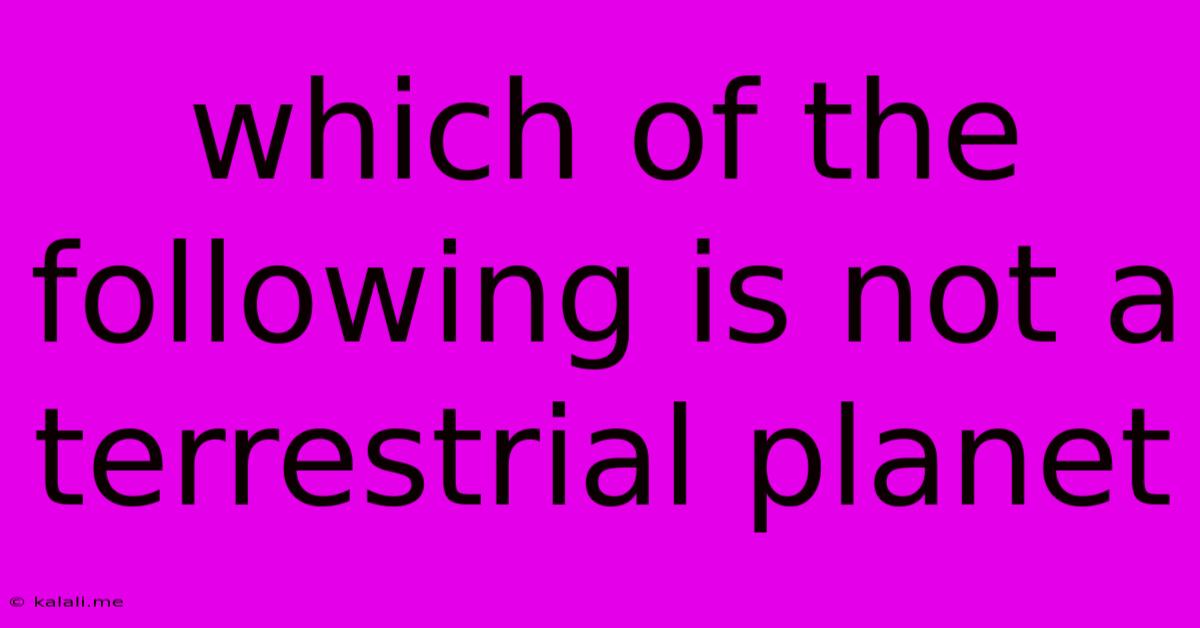Which Of The Following Is Not A Terrestrial Planet
Kalali
Jun 12, 2025 · 2 min read

Table of Contents
Which of the Following is NOT a Terrestrial Planet? Understanding Inner Solar System Worlds
This article will explore the characteristics of terrestrial planets and identify which of several celestial bodies doesn't fit the definition. We'll delve into the defining features of these rocky worlds and explain why one stands apart. Understanding the differences between terrestrial and gas giant planets is crucial for grasping our solar system's structure and the diverse environments within it.
What are Terrestrial Planets?
Terrestrial planets, also known as inner planets, are characterized by their rocky composition, relatively small size, and high density. They are primarily composed of silicate rocks and metals, unlike the gas giants which are largely composed of gas and liquid. Key features include:
- Solid Surface: They possess a solid, rocky crust.
- Few Moons (if any): They generally have few or no moons compared to the gas giants.
- Thin Atmospheres (or none): Their atmospheres, if present, are relatively thin compared to gas giants.
- High Density: They have a higher average density than gas giants.
Examples of terrestrial planets in our solar system include Mercury, Venus, Earth, and Mars.
The Outsider: Identifying the Non-Terrestrial Planet
Now let's consider some options and determine which one is not a terrestrial planet. Let's assume the options presented are:
- Mercury
- Venus
- Earth
- Mars
- Jupiter
- Saturn
Of the listed celestial bodies, Jupiter, Saturn (and indeed, Uranus and Neptune) are clearly not terrestrial planets. These are gas giants, possessing vast atmospheres composed primarily of hydrogen and helium, lacking a solid surface in the traditional sense, and having significantly lower densities than terrestrial planets.
Why are Gas Giants Different?
The differences between terrestrial and gas giant planets stem from their formation processes. Terrestrial planets formed closer to the Sun, where temperatures were hotter and lighter elements were blown away by the solar wind. This left behind heavier elements like rock and metal, which accreted to form the solid planets we know. Gas giants, on the other hand, formed further from the Sun, where lower temperatures allowed them to accumulate large amounts of hydrogen and helium, the most abundant elements in the early solar system. This resulted in their massive size and gaseous compositions.
Conclusion: Understanding Planetary Classification
Categorizing planets helps us understand the diverse environments and processes shaping our solar system. Recognizing the defining characteristics of terrestrial planets – their rocky composition, small size, high density, and solid surfaces – allows us to easily distinguish them from gas giants like Jupiter and Saturn, which exhibit very different properties due to their formation and composition. This fundamental understanding is crucial for further exploration of our solar system and the search for exoplanets beyond.
Latest Posts
Latest Posts
-
Transitive And Intransitive Verbs Exercises With Answers
Jun 13, 2025
-
What Number Is A Multiple Of 6
Jun 13, 2025
-
How Long Does It Take Earth To Complete One Rotation
Jun 13, 2025
-
Which Of The Following Came First
Jun 13, 2025
-
What Is The Lightest Element On The Periodic Table
Jun 13, 2025
Related Post
Thank you for visiting our website which covers about Which Of The Following Is Not A Terrestrial Planet . We hope the information provided has been useful to you. Feel free to contact us if you have any questions or need further assistance. See you next time and don't miss to bookmark.